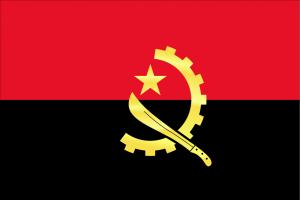You are here
Angola
Bandeira:

Links de interesse:
Documentos de referência:
Informações gerais:
Região:
Post date:
O Sistema de Saúde:
The Republic of Angola is located in the western region of Southern Africa, with an area of 1,246,700 km2. To the west it has an Atlantic coast of 1,650 km in length. It also has a land border extension of 4,837 which borders on the north with a Democratic Republic of Congo and the Democratic Republic of Congo to the east, with a Democratic Republic of Congo and the Republic of Zambia, and to the south with the Republic of Namibia.
The country is made up of 18 provinces, 166 municipalities and 530 communes. Within the political-administrative and operational framework of the decentralization and decentralization process, the Municipality of the School of Administration and Management.
The climate includes two seasons: the season of the year, the hottest period, which occurs between the week and May, and the less hot season of the Caça or Drought, which runs between May and September. On average, as the currency is a country between, 17 ° C, the minimum, and 27 ° C, the maximum.
Portuguse is an official language, spoken by about 83% of the Angolan population, mostly in urban areas. It can be seen that the provinces of Bié, Cunene, Moxico, Zaire, Lunda Sul and Kuando Kubango, more than half the population do not speak. Umbundo is a language found in 18 provinces. Kimbundu is a Monday nation not a more, but is more limited in space. Chokwe, Kikongo and Onghanaa, from all over the world, are of a high standard. To the one population predominantly young, in the meaning of the major than identity in English ,? The proportion of the population that identifies the national languages as their mother tongue is significantly lower than the identification with Portuguese.
The historical pattern of predominance of the Catholic religion prevails. About 50% of the population identifies themselves as Catholic and 33% as Protestant, despite the majority of the population after anism.
Angola has an estimated population of 18.5 million. The gradual increase in natural growth is around 3.1% per annum, but is in part a constant return of Angolans, once refugees in neighboring countries, as well as an increase in life expectancy. . The distribution serves 48 percent of men and 52 percent of women. Mostly, 55% 2 of the population is concentrated in urban areas and only 45% live in rural areas. (1%) in search of security and future opportunities.
The health system in Angola is basically divided into 3 levels: primary, secondary and tertiary. The primary network is open / health centers and municipal hospitals. A network of pink. (These two networks are administered by the provincial governments). The network is created by reference and national hospitals, cardiac surgery centers, Benguela ophthalmology center, hemodialysis centers and oncology treatment centers. This network depends on MINSA. The access to services for health regions is quite the regions regions, is called by patients which act. Health care in Angola is free, and the private network is obliged to provide first aid, regardless of the patient's purchasing power.
Luanda
The private health service continues to be very concentrated in its capital, Luanda, but they have the possibility of expanding throughout the country.
In Angola there are 7 medical schools, and in 2012 it had 3,085 doctors. In Luanda there are two of them, one public and the other private.
In addition, in all university centers, hospitals have been set up to boost medical courses, which make up 150 doctors per year. By 2013, with the formation of new colleges, the program should reach 250-300 physicians, and a target for the next 5 years is 500 to 600 physicians per year.
The current rate of infant mortality is equal to 150 to 116. The goal is to reach 1 to 3 thousand in the next 4 years - the possibility offered by the opening of new colleges and postgraduate centers.
Country Sanitary Profile
According to the National Health Development Plan 2012 - 20125 (August 2012), despite the significant increase in the country's main indicators of overall health, Angola still has a maternal, infant and child-to-juvenile mortality rate, a high incidence of infectious diseases and parasitic diseases such as severe endemias, respiratory and diurnal diseases, malnutrition still high in children under five, persistence of some of their children, weight gain and an exponential increase in chronic diseases, respiratory diseases and diarrheal diseases, a level of malnutrition still high in children under five years of age, persistent outbreaks of cholera, rabies and measles, and an exponential increase in chronic noncommunicable diseases (DCNT) , road fatalities and violence. Communicable diseases still account for more than 50% of deaths in the population.
The health needs and current problems facing the NHS are mainly related to: (i) insufficient health coverage and poor maintenance of the US; (ii) the weak system of reference and against reference among the three levels of the NHS; (iii) human and technical health personnel with reduced quantitative and qualitative expression and poor distribution of personnel in rural and peri-urban areas; (iv) weaknesses in the Health Management System, including the information, logistics and communication system; (v) insufficient financial resources and inadequacy of the financing model; and (vi) reduced access to drinking water, sanitation and energy.
References:
